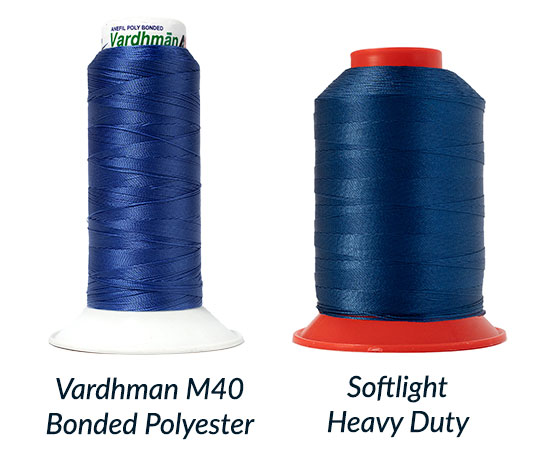Softlight Heavy Duty Thread VS Vardhman M40 Bonded Polyester
The difference between an M40 bonded polyester sewing thread and a non-bonded 70 Tex polyester sewing thread comes down to two main factors: the finish (bonded vs. non-bonded) and the sizing system (M40 vs. 70 Tex). While the M40 and 70 Tex threads are likely a similar thickness, the bonding is what truly differentiates them.
The Difference in Finish: Bonded vs. Non-Bonded
The most significant difference is the presence of a clear polyurethane or resin coating on the bonded thread. This coating, or "bonding," is applied during the manufacturing process and affects the thread's performance.

| Feature | Vardhman 500m M40 (Bonded Thread — M40) |
Softlight 1200m Tex 70 (Non-Bonded Thread — 70 Tex) |
|---|---|---|
| Finish | Coated with a polymer or resin. | Uncoated; often called a “soft” finish. |
| Feel | Stiffer and smoother. | Softer and more fibrous. |
| Sewing | Designed for high-speed industrial sewing and heavy-duty applications. The coating acts as a lubricant, reducing friction and heat as the thread passes through the needle and material — less shredding, fraying or breakage. | Better suited for slower sewing speeds or where a soft feel is desired. Without coating it has a higher risk of fraying or breaking under high tension or speed. |
| Durability | Coating locks plies together, giving excellent abrasion resistance and ply security — also improved resistance to UV, mildew and chemicals. | Lacks protective coating, so more prone to fraying and abrasion, especially with rough materials like leather or canvas. |
| Appearance | Smoother, more uniform look. Coating may make the spool colour appear slightly darker but it lightens once sewn. | More fibrous, natural look — similar to cotton thread. |
| Application | Ideal for demanding products: upholstery, footwear, outdoor gear and luggage. | Often used for general sewing, long straight seams, and as bobbin thread paired with a bonded top thread. Also useful where adhesion is needed (bonded coatings can repel adhesives). |
The Difference in Sizing: M40 vs. 70 Tex
The "M40" and "70 Tex" labels are different sizing systems used to describe the thread's thickness.
| Tex (T) | This is a direct measurement system. Tex 70 means that 1,000 meters of the thread weigh 70 grams. The higher the Tex number, the thicker the thread. It's a universal and consistent standard. |
| Metric Number (M) | This is an indirect system. M40 means that 40 meters of the thread weighs 1 gram. The higher the M number, the thinner the thread. |
While they use different scales, an M40 thread is generally comparable in thickness to a 70 Tex thread. Both are considered heavy-duty threads used for similar applications, but the "Tex" system is more common in industrial settings. So, in this specific comparison, the most significant functional difference is the presence or absence of the bonding agent, not the thread's size.



